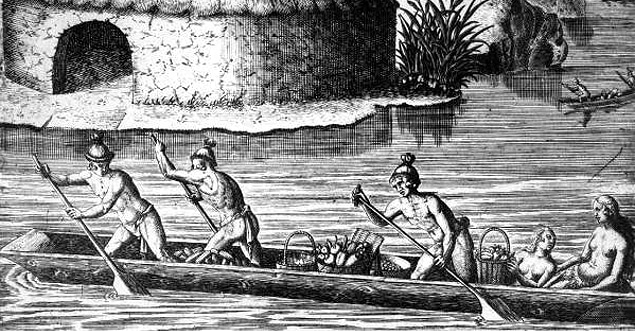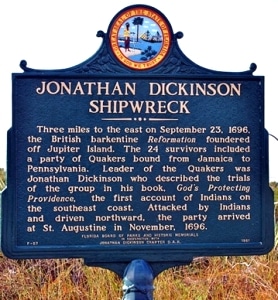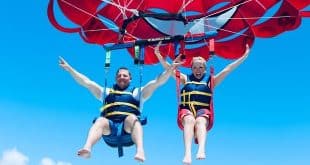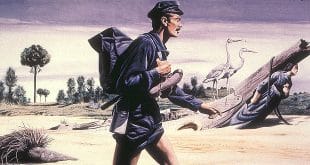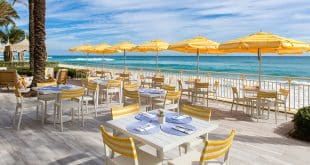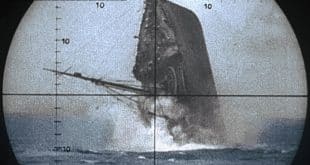In late April 1519, Juan Ponce de Leon made landfall at the Jupiter Inlet (Rio de la Cruz) with two ships, the Santa Maria de la Consolacion and the Santiago, to replenish water and firewood, and wait for a third ship, the Cristobal, to rejoin them. They were met by the Jeaga, Native Americans from a nearby village (Jobe), who knocked one of the Spaniards unconscious with a staff and wounded two with arrows tipped with bone and fish spines. Ponce de Leon and his men fought off the attackers and docked there for a week before the three ships sailed a little further south and anchored off of Palm Beach (Abaioa) where they encountered no hostilities. Apparently, word traveled fast about the strange ironclad men and their monstrous sailing vessels.
The Jeaga occupied an area that fits almost perfectly within the boundaries of present-day Palm Beach County, from the Boca Raton inlet to just north of the Jupiter Inlet. At their pre-Columbian height they numbered over 2,000 and recent archaeological digs suggest they arrived in the area as long as 5,000 years ago from the Taino culture in the Caribbean. All members of the Jeaga tribe were related through blood or marriage.
The Jeaga were experts at carving canoes from cypress trees and they navigated Florida’s interior to Lake Okeechobee and throughout south Florida to trade with other tribes. They traded with the Ais to the north, the Tekesta to the south and the powerful Calusa tribe that ruled southwest Florida. Jeaga men wore breechcloths of woven grass, while the women created skirts from Spanish moss. They lived in wigwam-style homes consisting of wooden poles stuck into the ground and covered with palmetto leaves. The Jeaga were hunter-gatherers who subsisted mostly on sea turtles and oysters, as well as conch, fish, deer, raccoon, manatee, alligator and shark. They also collected wild plants including coco palms, sea grapes and palmetto berries.
Besides ceremonial mounds and foundations of complexes, the Jeaga left behind large middens, massive refuse piles of bones, shells and pottery, throughout Palm Beach County. The piece of check-stamped pottery shown in this article was discovered by the author (David J Castello) in a Jeaga midden just south of the Boynton Beach Inlet.
Throughout the 16th and 17th centuries, the Jeaga, particularly those in Jobe, gained power and influence by salvaging materials from ships wrecked along the coast of Palm Beach County. The Gulf Stream current runs closer to Palm Beach County than anywhere else in the United States and hurricanes forced many sailing ships ashore.
When Jonathan Dickinson was shipwrecked on Jupiter Island during a hurricane in 1696, he and his twenty-three shipmates encountered the Jeaga from Jobe who relieved them of their clothes and possessions. They were held hostage in the village for a few days until the Jeaga allowed them to walk north along the beach where they were met by the Santaluces at the St. Lucie River and the Ais near present-day Fort Pierce. Early on, Dickinson learned that the Jeaga, Santaluces and Ais hated the English, but feared the Spanish. It would be a death sentence if any of them spoke English, so they secretly delegated all communication with the tribes to Solomon Cresson, who spoke fluent Spanish. Five members of the castaways died from exposure, but the rest made it to safety by trekking over two hundred miles to the Spanish fort in St. Augustine. Jonathan Dickinson later became mayor of Philadelphia.
Starting in 1703, during Queen Anne’s War between England and Spain, the Jeaga were kidnapped into slavery and their villages ransacked by English slave traders from the Carolina Colony who were assisted by the Yemassee and Yuchi tribes. By 1711, the last Jeaga chief was desperately seeking sanctuary from the Spanish in Cuba for the remaining members of his tribe who were hiding out in the Florida Keys with 2,000 other Floridian Native Americans. Captain Luis Perdomo arrived with two ships from Havana, but could only rescue 270 of the refugees. Possessing no immunity, most died from disease within a few years in Cuba.
BEST West Palm Beach Concert & Event Tickets!
Want the Best Price for a West Palm Beach Hotel?

WestPalmBeach.com
The Visitor’s Guide to West Palm Beach!

